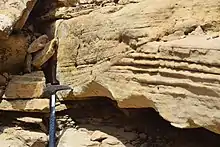
Cross beds in siliciclastic shoreface sediment (Agadir-Essaouira Basin, Morocco)
Siliciclastic (or siliclastic[1]) rocks are clastic noncarbonate sedimentary rocks that are composed primarily of silicate minerals, such as quartz or clay minerals. Siliciclastic rock types include mudrock, sandstone, and conglomerate.[1][2]
Siliciclastic sediments are silica-based sediments, lacking carbon compounds, which are formed from pre-existing rocks, by breakage, transportation and redeposition to form sedimentary rock.[3]
References
- 1 2 Allaby, Michael (2013). "siliclastic". A dictionary of geology and earth sciences (Fourth ed.). Oxford: Oxford University Press. ISBN 9780199653065.
- ↑ Jackson, Julia A., ed. (1997). "siliciclastic". Glossary of geology (Fourth ed.). Alexandria, Virginia: American Geological Institute. ISBN 0922152349.
- ↑ Oilfield Glossary: siliciclastic sediment. Retrieved 23 August 2018.
This article is issued from Wikipedia. The text is licensed under Creative Commons - Attribution - Sharealike. Additional terms may apply for the media files.